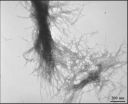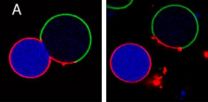(Press-News.org) OAK RIDGE, Tenn., May 18, 2011 – Researchers at the Department of Energy's Oak Ridge National Laboratory and the University of Tennessee have for the first time successfully characterized the earliest structural formation of the disease type of the protein that causes Huntington's disease. The incurable, hereditary neurological disorder is always fatal and affects one in 10,000 Americans.
Huntington's disease is caused by a renegade protein "huntingtin" that destroys neurons in areas of the brain concerned with the emotions, intellect and movement. All humans have the normal huntingtin protein, which is known to be essential to human life, although its true biological functions remain unclear.
Christopher Stanley, a Shull Fellow in the Neutron Scattering Science Division at ORNL, and Valerie Berthelier, a UT Graduate School of Medicine researcher who studies protein folding and misfolding in Huntington's, have used a small-angle neutron scattering instrument, called Bio-SANS, at ORNL's High Flux Isotope Reactor to explore the earliest aggregate species of the protein that are believed to be the most toxic.
Stanley and Berthelier, in research published today in Biophysical Journal, were able to determine the size and mass of the mutant protein structures―from the earliest small, spherical precursor species composed of two (dimers) and three (trimers) peptides―along the aggregation pathway to the development of the resulting, later-stage fibrils. They were also able to see inside the later-stage fibrils and determine their internal structure, which provides additional insight into how the peptides aggregate.
"Bio-SANS is a great instrument for taking time-resolved snapshots. You can look at how this stuff changes as a function of time and be able to catch the structures at the earliest of times," Stanley said. "When you study several of these types of systems with different glutamines or different conditions, you begin to learn more and more about the nature of these aggregates and how they begin forming."
Normal huntingtin contains a region of 10 to 20 glutamine amino acids in succession. However, the DNA of Huntington's disease patients encodes for 37 or more glutamines, causing instability in huntingtin fragments that contain this abnormally long glutamine repeat. Consequentially, the mutant protein fragment cannot be degraded normally and instead forms deposits of fibrils in neurons.
Those deposits, or clumps, were originally seen as the cause of the devastation that ensues in the brain. More recently researchers think the clumping may actually be a kind of biological housecleaning, an attempt by the brain cells to clean out these toxic proteins from places where they are destructive. Stanley and Berthelier set out to learn through neutron scattering what the toxic proteins were and when and where they occurred.
At the HFIR Bio-SANS instrument, the neutron beam comes through a series of mirrors that focus it on the sample. The neutrons interact with the sample, providing data on its atomic structure, and then the neutrons scatter, to be picked up by a detector. From the data the detector sends of the scattering pattern, researchers can deduce at a scale of less than billionths of a meter the size and shape of the diseased, aggregating protein, at each time-step along its growth pathway.
SANS was able to distinguish the small peptide aggregates in the sample solution from the rapidly forming and growing larger aggregates that are simultaneously present. In separate experiments, they were able to monitor the disappearance of the single peptides, as well as the formation of the mature fibrils.
Now that they know the structures, the hope is to develop drugs that can counteract the toxic properties in the early stages, or dissuade them from taking the path to toxicity. "The next step would be, let's take drug molecules and see how they can interact and affect these structures," Stanley said.
For now, the researchers believes Bio-SANS will be useful in the further study of Huntington's disease aggregates and applicable for the study of other protein aggregation processes, such as those involved in Alzheimer's and Parkinson's diseases.
"That is the future hope. Right now, we feel like we are making a positive contribution towards that goal," Stanley said.
INFORMATION:
The research was supported by the National Institutes of Health. HFIR and Bio-SANS are supported by the DOE Office of Science.
ORNL is managed by UT-Battelle for the Department of Energy's Office of Science.
NOTE TO EDITORS: You may read other press releases from Oak Ridge National Laboratory or learn more about the lab at http://www.ornl.gov/news. Additional information about ORNL is available at the sites below:
Twitter - http://twitter.com/oakridgelabnews
RSS Feeds - http://www.ornl.gov/ornlhome/rss_feeds.shtml
Flickr - http://www.flickr.com/photos/oakridgelab
YouTube - http://www.youtube.com/user/OakRidgeNationalLab
LinkedIn - http://www.linkedin.com/companies/oak-ridge-national-laboratory
Facebook - http://www.facebook.com/Oak.Ridge.National.Laboratory
Neutrons provide first sub-nanoscale snapshots of Huntington's disease protein
2011-05-19
ELSE PRESS RELEASES FROM THIS DATE:
Virtual workout partners spur better results
2011-05-19
EAST LANSING, Mich. — Can't find anyone to exercise with? Don't despair: New research from Michigan State University reveals working out with a virtual partner improves motivation during exercise.
The study led by Deborah Feltz, chairperson of MSU's Department of Kinesiology, is the first to investigate the Kohler effect on motivation in health video games; that phenomenon explains why inferior team members perform better in a group than they would by themselves.
The research, to be published in an upcoming edition of the Journal of Sport and Exercise Psychology, was ...
New technique sheds light on the mysterious process of cell division
2011-05-19
Using a new technique in which models of primitive cells are constructed from the bottom up, scientists have demonstrated that the structure of a cell's membrane and cytoplasm may be as important to cell division as the specialized machinery -- such as enzymes, DNA or RNA -- which are found within living cells. Christine Keating, an associate professor of chemistry at Penn State University, and Meghan Andes-Koback, a graduate student in the Penn State Department of Chemistry, generated simple, non-living model "cells" with which they established that asymmetric division ...
The Luminosity Rapid eLearning Authoring Platform From CM Group Now Available to Smaller Producers; New Cloud-Based Luminosity Server Enables Low-Cost eLearning Creation for All
2011-05-19
The new annual rental model is just $1,395 per author pa with full access to a secure cloud based server to facilitate full author collaboration and stakeholders' review.
Luminosity's architecture means that there is a small piece of software that is installed on the author's PC. The author can work offline and not rely on a constant internet connection. When authors next go onto the internet they can sync up with the server at that time. This is ideal for authors who do not have constant high bandwidth internet access. It also fully supports those authors working individually ...
Researchers discover that lymphocyte count indicates prognosis of patients with renal cell carcinoma
2011-05-19
CHICAGO, IL (May 18, 2011)––Each year, kidney cancer is diagnosed in nearly 60,000 people in the U.S. Many of these patients undergo surgery to remove the affected kidney, but this procedure can be risky for the elderly and those who have other health problems. Unfortunately, the prognosis of kidney cancer patients often cannot be determined until tumor samples are surgically removed and evaluated. Now, researchers at Fox Chase Cancer Center have discovered that the lymphocyte count––which is routinely measured in laboratory tests––is a simple and effective prognostic ...
Recurring cancers in women with a history of breast cancer differ from the original tumors
2011-05-19
CHICAGO, IL (May 18, 2011)––When women with a history of breast cancer learn they have breast cancer again, one of the first questions they and their doctors ask is: Has my cancer come back, or is this a new case? Now, new data from Fox Chase Cancer Center suggest that both new and recurring cancers will differ significantly from the original tumors, regardless of how many months or years women spent cancer-free, and doctors should tailor treatment to the specific qualities of the second tumor, regardless of whether it's old or new.
Anita Patt, MD, surgical oncology ...
Develop iPhone and iPad Applications in Minutes, Easily Creating Complex Forms, with Validation, Save and Manage Data, Using IOSKit from Knovial
2011-05-19
In light of the iPhone and the iPad's growing popularity and usage among today's consumers, the demand for various applications that can be downloaded and used via iPhones and iPads has skyrocketed. There is an application for virtually every aspect of daily living: games, fitness management, business organization, social networking, health care systems, and the list go on. Thus, programmers have recognized the potential success in developing applications for the iPhone and the iPad. However, it's a fact that a lot of programmers spend hundreds of hours trying to build ...
Enzyme may drive breast cancer growth
2011-05-19
A recently discovered enzyme drives the production of a potent form of estrogen in human breast cancer tissue, researchers from the University of Illinois at Chicago College of Medicine have found.
The extra-strength estrogen, called estradiol, then drives the production of even more enzyme, in what may be a lethal feed-forward mechanism. Estradiol has been implicated in exacerbating tumor growth in breast cancer.
The research is published in the May issue of the journal Molecular Endocrinology.
Scientists had observed the increased production of an unknown protein ...
Carbon black nanoparticles can cause cell death
2011-05-19
Researchers from the University of Iowa Roy J. and Lucille A. Carver College of Medicine have found that inhaled carbon black nanoparticles create a double source of inflammation in the lungs.
Their findings were published online in the April 27 edition of the Journal of Biological Chemistry. Martha Monick, Ph.D., UI professor of internal medicine, was lead author of the paper, "Induction of Inflammasome Dependent Pyroptosis by Carbon Black Nanoparticles," which outlined the results.
Monick said researchers expected to find one level of inflammation when cells were ...
24-7PressRelease Announces Launch of Partnership with Prompt Proofing to Meet All PR Needs for Customers
2011-05-19
Well-known press release distribution service, 24-7PressRelease.com, recently announced its partnership with press release writing, editing and copy writing service, Prompt Proofing.
24-7PressRelease.com has a faithful following with more than 60,000 customers and is in its seventh year of business. Offering distribution packages for all price points, the press release service has a service for every business, no matter how big or small. Customers submit releases through the easy-to-use self-serve system on 24-7PressRelease.com's website, and the company's editors will ...
Electronic medical records lower infant mortality, study finds
2011-05-19
Expanded use of electronic medical records would substantially reduce infant mortality in the U.S., according to a study forthcoming in the Journal of Political Economy.
A 10 percent increase in hospital use of basic electronic records would save 16 babies for every 100,000 live births, the study found. A complete national transition to electronic records would save an estimated 6,400 infants each year in the U.S.
Many health professionals have advocated electronic records as a way to improve care and curb costs. For obstetricians, electronic records might make it ...


